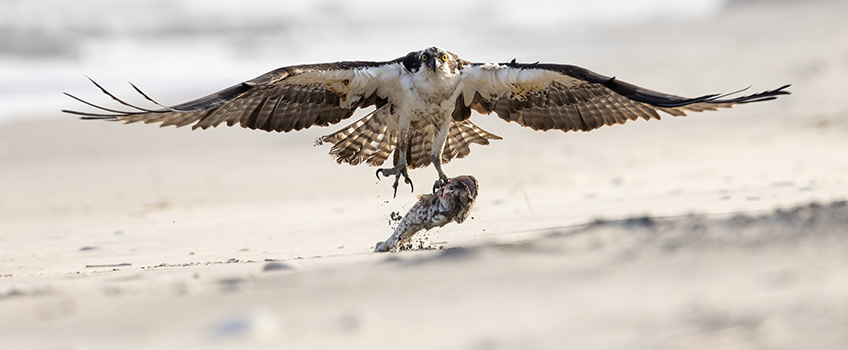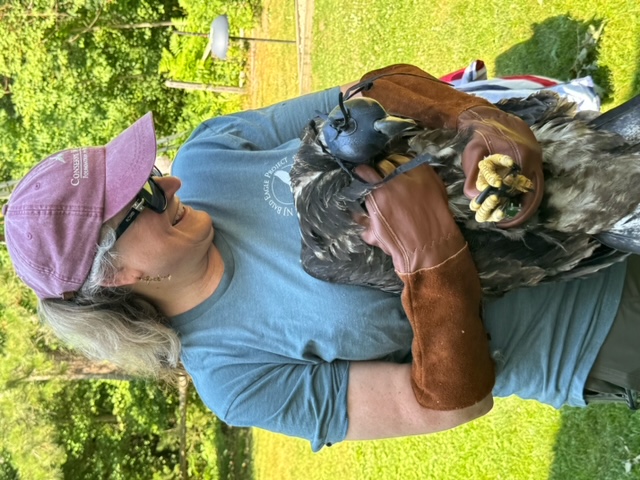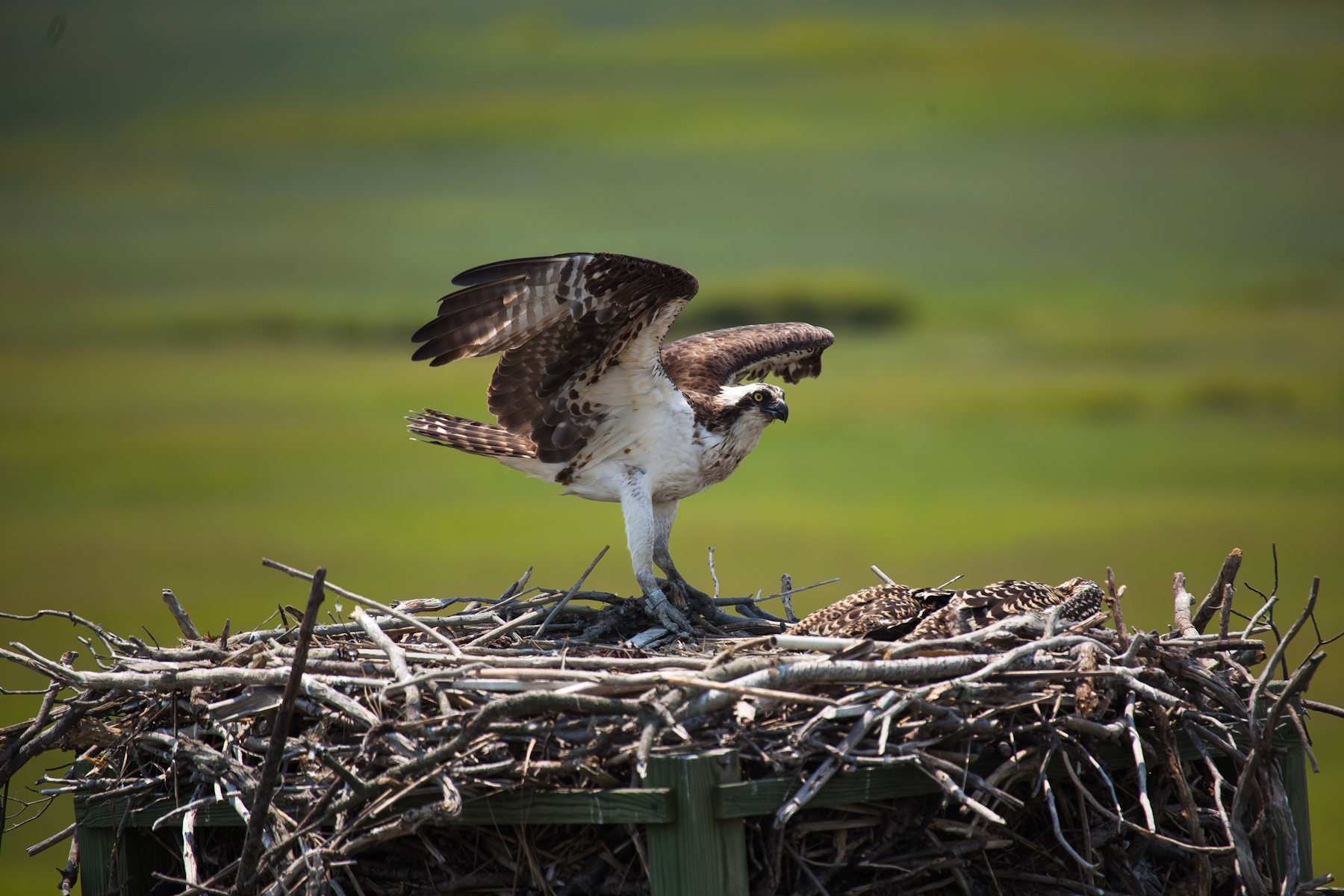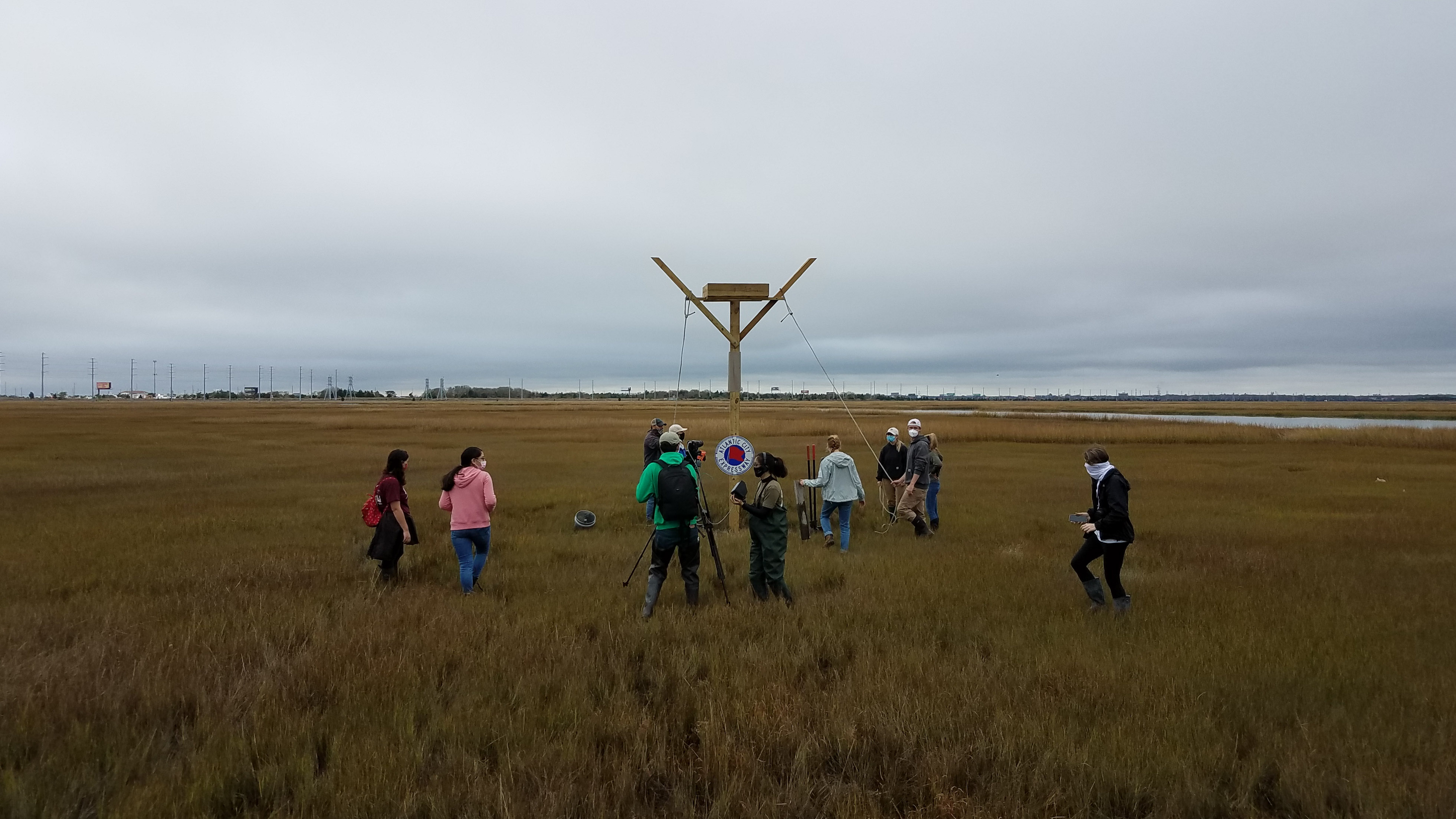Conservation Efforts Help Our Osprey Mascot

An osprey catches a bluefish in Ocean City and devours it on the beach since it was too heavy to fly any further. Photo: Susan Allen
Update: Since this story was published, the osprey and bald eagle have been removed from the state's list of endangered species. The Department of Environmental Protection made the announcement on Jan. 6, 2025.
Galloway, N.J. - When Stockton University chose the osprey as its official mascot in the early 1970s, the fish hawk was an endangered species with only 50 or so nesting pairs left in New Jersey. Bald eagles were down to one nesting pair that repeatedly failed to hatch eggs.
Now, five decades later, the effects of statewide conservation efforts have prompted the New Jersey Department of Environmental Protection to consider delisting the osprey and the bald eagle from the state's list of endangered species.
DDT, a pesticide used in agriculture, caused reproductive failure for both ospreys and bald eagles as well as other birds of prey.
"Being at the top of the food chain, DDT concentrated in their prey items and unfortunately one of the end results was thinning of the eggshells. The eggs would be laid, and if they did not break at the onset, usually a couple days into incubation, they would crack under the parents' weight," explained John Rokita '78, assistant supervisor of academic lab services and a Stockton Biology graduate.
The Osprey Mascot
Stockton was in the midst of choosing its mascot during the osprey's struggle for survival. There were 44 mascot suggestions written on the blackboard during a College Council meeting when Sandra Bierbrauer, professor emeritus of Genetics, added the osprey. The seagulls, blueberry pickers, pine coners and clam diggers were no competition for the osprey that soared to the winning choice. Student Senate later hosted a contest to name our mascot Talon.
Saving New Jersey's Last Eagle Pair
Rokita still remembers holding eggs laid by New Jersey's last eagle pair on a car ride from Cumberland County to Patuxent, Maryland. He was working in the Animal Lab at Stockton and volunteering at Mark and Martha Pokras's Avian Rehabilitation Center when he was asked to assist with a state effort to save New Jersey's bald eagle population.
In the old-growth forest of Bear Swamp, a tree climber ascended through the branches to the eagle nest and took their fragile eggs. They were replaced with wooden replicas to ensure the pair would not abandon the nest. "It was a big, old pine tree and the nest was way up there. When he went into the nest, you could only see his head peering out," Rokita remembered.
Meanwhile, at the Patuxent Wildlife Research Center, captive bald eagles that could not be released were successfully breeding because they were not feeding on prey affected by DDT. Their young, raised in captivity, were placed in wild nests around the country.
Patuxent also had mechanical incubators and chickens that could incubate eggs taken from failing nests.
"It was an honor to hold that clutch of eggs. I was the suitcase holder and thermometer watcher. If it got too warm, it was my job to let warm air, out and if it got too chilly, to keep it closed. It was regulated by hot water bottles," he recalled.
When New Jersey's last eagle pair was due to hatch their eggs, the climber returned to remove the wooden eggs and leave the pair with chicks.
Two of the chicks were hatched from the pair's own eggs, while another was a similar aged chick from a captive pair at Patuxent.
"When the bald eagle parents came back still in the incubation frame of mind, the eggs were gone and there were 2-3-week-old chicks. It took a little while, but then they started feeding them as if they were their own," Rokita said.
The swap took place with downy chicks, since hatchlings could perish in the time it took the parents to come back to the nest.
Later in the 1980s, Rokita assisted Kathy Clark, now chief of the state's Endangered and Nongame Species Program, in collecting blood samples from osprey chicks in Ocean City. The samples would help researchers monitor DDT levels in the birds after the chemical was banned in 1972.
Conservation Continues for Ongoing Success
 Eagle conservation efforts continue today. Larissa Smith '90, an Environmental Studies
graduate who is now a senior wildlife biologist with the Conserve Wildlife Foundation
of New Jersey, coordinates volunteers and works on the New Jersey Bald Eagle project.
Eagle conservation efforts continue today. Larissa Smith '90, an Environmental Studies
graduate who is now a senior wildlife biologist with the Conserve Wildlife Foundation
of New Jersey, coordinates volunteers and works on the New Jersey Bald Eagle project.
When she began working with bald eagles in 2000, the New Jersey Division of Fish and Wildlife's Endangered and Nongame Species Program had already begun recovery efforts, the same work Rokita was involved with in the 1980s, to save the state's last nesting pair.
"When I began working with bald eagles there were 25 nesting pairs and a handful of volunteers who monitored these nests. Today we are now monitoring over 300 nesting pairs and have a dedicated group of over 155 volunteers," she said.
Volunteers monitor eagle nests across the state during nesting season by tracking incubation, hatching and fledging dates, which are published in an annual report.
Although Smith notes the satisfaction of witnessing the eagle comeback over 24 years, she warns of the challenges they still face such as habitat loss, disturbance and lead poisoning. "Even though bald eagles are up for delisting in New Jersey, we will continue to monitor the population making sure that they continue to thrive," she said.
Bill Reinert '79, a Marine Science graduate who worked for 35 years with Atlantic County's Office of Mosquito Control, is one of the Bald Eagle Project volunteers. "It was an opportunity to get back out on the marsh. To me, that's heaven," he said.
He started with one nest three years ago, and now this season he monitored four. Starting in late December, he began making weekly visits to the nests to document egg laying and hatching. "You see some interesting stuff and sometimes you are surprised," he said.
For a few weeks, he thought one of the nests only had a single chick, but then one day, a second finally made itself visible. The nests are distant, so he uses a scope to get a closer look.
This summer he joined two osprey nesting surveys. Last year, summer storms and lower bunker availability when the chicks were hatching presented challenges, but this year looks promising, he noted.
To celebrate the wild population of our osprey and bald eagles making a comeback, we have highlighted past coverage of Stockton's involvement in conservation efforts.
Story by Susan Allen
At 20:57 minutes into this NJN documentary, "Ospreys: A Success Story," John Rokita is pictured with Carol Newcomb, his co-worker at the Avian Rehabilitation Center at the time, hand feeding an osprey patient.





